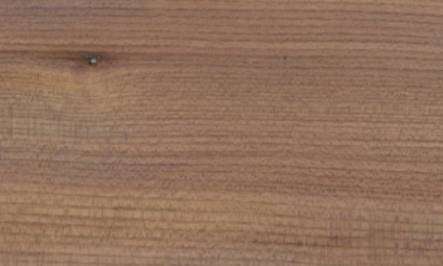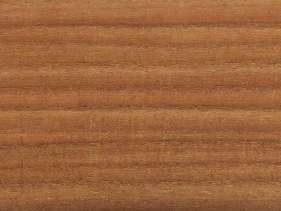 
Slippery elm (Ulmus rubra)
Family:
Common names: Elm, Gray elm, Red elm, Slippery elm, Soft elm
Distributed in: Canada, United States (North America)
Distribution overview: The growth range of Slippery elm in North America extends from southern Ontario east to extreme southern Quebec and southwest Maine, south to northwest Florida, west to central Texas, and north to southeast North Dakota. It is often found in hardwood forests, particularly on lower slopes and flood plains, but often on dry uplands. It thrives on moist soils.
Common uses: Baskets, Boxes and crates, Building materials, Casks, Cooperages, Decorative plywood, Decorative veneer, Farm vehicles, Figured veneer, Food containers, Interior construction, Interior trim, Machinery parts, Millwork, Moldings, Packing cases, Pallets, Plywood, Skids, Trimming, Vehicle parts, Veneer, Wainscotting, Wheels
Product sources: The timber is commonly mixed and sold together with American elm under the trade name 'Elm' or 'Soft elm'. Prices are in the moderate range and supplies are high.
Environment profile: Status has not been officially assessed
Tree size: Trunk diameter is 100-150 cm
Colors: the heart isDark brown, Yellowand the sapwoodLight brown, Yellow.The grain isStraight, the textureFineand the lusterMedium
Natural durability: Susceptible to attack by fungi, Very little natural resistance
Odor: No characteristic taste
Silica Content: Siliceous
Kiln Schedules: T6 - D4 (4/4) US
Drying Defects: Distortion, Warping can be expected
Ease of Drying: Medium to High Shrinkage
Air-Seasons at a more rapid rate than most woods, but requires low temperatures in kiln drying
Comments: Wood contains yellow and orange compounds, which can be removed with benezene
Boring: Bores well, although heavy, strong, and very tough
Cutting Resistance: Woolly
Mortising: Easy to mortise
Nailing: Good nailing properties, Holds nails well
Planing: Irregular grain interferes
Resistance to Impregnation: Responds well to treatment
Sanding: Satisfactory
Steam bending: Excellent response
Screwing: Possible if prebored
; Turning:
Wild grain requires some care in turning operations
Polishing: Fair to Good; Staining: Responds well to conventional finishes
;
- Numerical data Metric
- Numerical data English
- Strength properties
- References
 |
 |
 |
 |
| Item |
Green |
Dry |
Metric |
| Specific Gravity |
0,47 |
0,56 |
|
| Density |
|
|
kg/m3 |
| Bending Strength |
558 |
847 |
kg/cm2 |
| Crushing Strength |
32 |
60 |
kg/cm2 |
| Hardness |
|
382 |
kg |
| Impact Strength |
152 |
170 |
cm |
| Shearing Strength |
|
112 |
kg/cm2 |
| Stiffness |
85 |
103 |
1000 kg/cm2 |
| Tangential Shrinkage |
10 |
|
% |
| Radial Shrinkage |
4 |
|
% |
| Weight |
865 |
608 |
kg/m3 |
| Maximum Load |
1,26 |
1,26 |
cm-kg/cm3 |
| Toughness |
|
|
cm-kg |
| Static Bending |
268 |
310 |
kg/cm2 |
|
 |  |  |  | | Item | Green | Dry | English | | Bending Strength | 7938 | 12054 | psi | | Crushing Strength | 461 | 862 | psi | | Hardness | | 843 | lbs | | Impact Strength | 60 | 67 | inches | | Maximum Crushing Strength | 3317 | 5836 | psi | | Shearing Strength | | 1597 | psi | | Static Bending | 3822 | 4410 | psi | | Stiffness | 1220 | 1470 | 1000 psi | | Work to Maximum Load | 18 | 18 | inch-lbs/in3 | | Specific Gravity | 0.47 | 0.56 | | | Weight | 54 | 38 | lbs/ft3 | | Radial Shrinkage | 4 | | % | | Tangential Shrinkage | 10 | | % | | Volumetric Shrinkage | 15 | | % | |
Strenght properties are good, average resistance to shock and abrasion
Boone, R.S., C.J. Kozlik, P.J. Bois and E.M. Wengert. 1988. Dry Kiln Schedules for Commercial Woods: Temperate and Tropical. United States Department of Agriculture, Forest Service, Forest Products Laboratory, General Technical Report FPL-GTR-57, Madison, Wisconsin.Canadian Forestry Service. 1981.Canadian Woods - Their Properties and Uses. Third Edition. E.J. Mullins and T.S. McKnight, Editors. Published by University of Toronto Press, Toronto, Canada.Kline, M. 1986. Ulmus rubra - Slippery elm. In A Guide to Useful Woods of the World. Flynn Jr., J.H., Editor. King Philip Publishing Co., Portland, Maine. 1994. Page 357.Little, E.L.1980.The Audubon Society Field Guide to North American Trees - Eastern Region.Published by Arthur A. Konpf, New York.Panshin, A.J. and C. deZeeuw. 1980. Textbook of Wood Technology, 4th Edition. McGraw-Hill Series in Forest Resources. McGraw-Hill Book Company, New York.USDA. 1987. Wood Handbook - Wood as an Engineering Material, Forest Service, Agriculture Handbook No. 72, Forest Products Laboratory, Madison, Wisconsin.USDA. 1988. Dry Kiln Operators Manual, Preliminary Copy. Forest Service, Forest Products Laboratory, Madison, Wisconsin.
|









